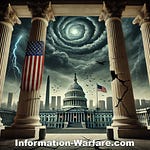The Global Power Shift No One Can Ignore
As NATO fractures and BRICS expands, Western nations risk losing economic and technological dominance. Is the world entering a new era where the second tier becomes the first?
The Rise of BRICS and the Decline of NATO:
How the Global Order is Being Rewritten
The world as we know it is shifting. The alliances that defined the post-World War II era — the ones that built a Western-dominated global economy, secured technological leadership, and maintained military superiority — are unraveling. At the same time, a new world order is emerging, led by nations once considered second-tier economic players.
If this trajectory continues, we are heading toward a global realignment where first-world nations slide into second-tier economic status, and the second world takes control of the industries of the future — batteries, semiconductors, artificial intelligence, energy, and manufacturing. This isn’t just speculation — it’s already happening.
At the heart of this transformation are two forces accelerating the collapse of the Western-led world order:
Donald Trump and Vladimir Putin.
NATO’s Waning Influence: A Fractured Alliance
For over 70 years, NATO has been the cornerstone of Western security and geopolitical dominance. It has deterred Russian expansionism, secured economic stability in Europe, and protected the global balance of power. But today, NATO is losing its grip — both politically and militarily.
Trump’s Assault on NATO: During his presidency, Donald Trump actively weakened NATO by questioning its relevance, undermining allies, and threatening to withdraw from the alliance. His hostility emboldened Russia and created deep fractures among member states. Even now, his return to power would signal the possible end of NATO as an effective force.
Putin’s Strategic Disruptions: Through cyber warfare, military aggression (Ukraine), and strategic alliances (China, Iran, North Korea), Putin has successfully challenged NATO’s unity. Many European countries are now questioning their reliance on an American-led security framework, especially with Trump’s return looming.
Europe’s Economic Struggles: NATO members, particularly in Europe, are facing stagnant growth, deindustrialization, and energy dependence (especially after Russia weaponized gas exports). The war in Ukraine has drained resources, and without U.S. backing, NATO’s future remains uncertain.
The Rise of BRICS: A New Economic Powerhouse
While NATO is weakening, BRICS (Brazil, Russia, India, China, South Africa) is expanding its reach. Originally founded as an economic alliance, BRICS is now emerging as a geopolitical counterbalance to Western dominance.
How BRICS is Reshaping the Global Economy:
Expanding Membership with Resource-Rich Nations
New additions like Saudi Arabia, UAE, Iran, Argentina, and Egypt are bringing vast energy reserves, industrial capacity, and trade networks to BRICS.
Unlike NATO, which struggles to maintain unity, BRICS is growing stronger by aligning economic interests across continents.
Control Over Future Industries
China and India are leading in AI, semiconductors, and electric batteries. Meanwhile, Western nations are losing their technological edge due to manufacturing outsourcing and stagnation.
Russia, Iran, and Saudi Arabia dominate global energy markets. As the West shifts away from fossil fuels, these nations are redirecting their exports to BRICS members, strengthening internal trade.
Dedollarization and Financial Independence
BRICS is actively reducing dependence on the U.S. dollar.
China and Russia are conducting trade in yuan and rubles, weakening the dollar’s status as the global reserve currency.
A BRICS-led alternative to SWIFT (the Western banking system) is being developed, allowing these nations to operate independently of Western financial sanctions.
Global Trade Realignment
The West is struggling with supply chain disruptions, while BRICS strengthens intra-member trade networks to bypass Western control.
Africa and Latin America — once dependent on Western trade — are increasingly shifting toward China and India, further reducing NATO’s global influence.
The Consequences: First-World Nations Becoming Second-World Economies
If this trajectory continues, the economic and technological dominance of the U.S. and its allies will fade. Instead of setting global rules, Western nations will become followers in a BRICS-led economic order.
Key Industries at Risk:
Batteries & Green Energy
China dominates 80% of the world’s lithium refining and battery production. The West is playing catch-up, but BRICS is already securing key raw materials from Africa and Latin America.
The U.S. risks becoming dependent on BRICS for the technology that will drive the future of transportation and energy.
Semiconductors & AI
The West still holds an edge, but China is rapidly closing the gap in AI, supercomputing, and chip manufacturing.
Taiwan, a key semiconductor hub, is at risk of Chinese invasion, which would cripple the U.S. tech sector overnight.
Energy & Natural Resources
With BRICS controlling oil, gas, and rare minerals, the West faces a future of resource dependency.
Russia, Iran, and Saudi Arabia are rewiring global energy markets, bypassing Western sanctions, and forming stronger economic ties with China and India.
Defense & Military Power
The Western defense industry is overextended due to Ukraine, while China and Russia are rapidly modernizing their military capabilities.
If NATO collapses, the U.S. and Europe will struggle to maintain military superiority in key global regions.
Who is Responsible? The Trump-Putin Factor
At the center of this geopolitical shift are two men actively working to dismantle Western power — Donald Trump and Vladimir Putin.
Trump has weakened U.S. alliances, undermined NATO, and driven a wedge between Western nations. His “America First” policy isolated the U.S. from its traditional partners, creating a vacuum for BRICS to expand.
Putin, through both military and economic strategy, has accelerated the rise of BRICS and the decline of NATO. His war in Ukraine forced Europe into economic turmoil, while his alignment with China, Iran, and North Korea is reshaping global power dynamics.
Together, they are orchestrating the collapse of the Western-led order — brick by brick.
What Must Be Done?
If the West wants to avoid economic and technological decline, urgent action is needed.
Reinforce NATO and Western Alliances
The U.S. must reaffirm its commitment to NATO and strengthen security ties with Europe and the Indo-Pacific.
Trump’s isolationist approach must be rejected — global leadership is essential to counter BRICS expansion.
Secure Critical Industries
The U.S. and its allies must invest aggressively in domestic semiconductor, battery, and AI industries to reduce dependence on BRICS nations.
Strengthening energy independence (including nuclear and renewable sources) is critical.
Counter BRICS Financial Strategies
The West must defend the dollar’s dominance and prevent BRICS nations from establishing an alternative global financial system.
Economic sanctions should target BRICS financial networks to slow their ability to bypass Western controls.
Fight Misinformation and Political Destabilization
Trump and Putin have weaponized propaganda to divide and weaken Western nations.
Governments must crack down on disinformation, protect democratic institutions, and prevent foreign interference in elections.
Conclusion: The Time to Act is Now
The world is being restructured before our eyes — brick by brick. If NATO continues to weaken and BRICS expands unchecked, the balance of power will shift permanently.
First-world nations will lose their economic and technological edge, slipping into second-tier status, while BRICS controls the industries that define the future.
The forces shaping this calamity?
Donald Trump and Vladimir Putin.











